A Quick Word on Intel Xeon 6980P Power
We usually try to avoid testing power consumption in development platforms, but that is all we had.
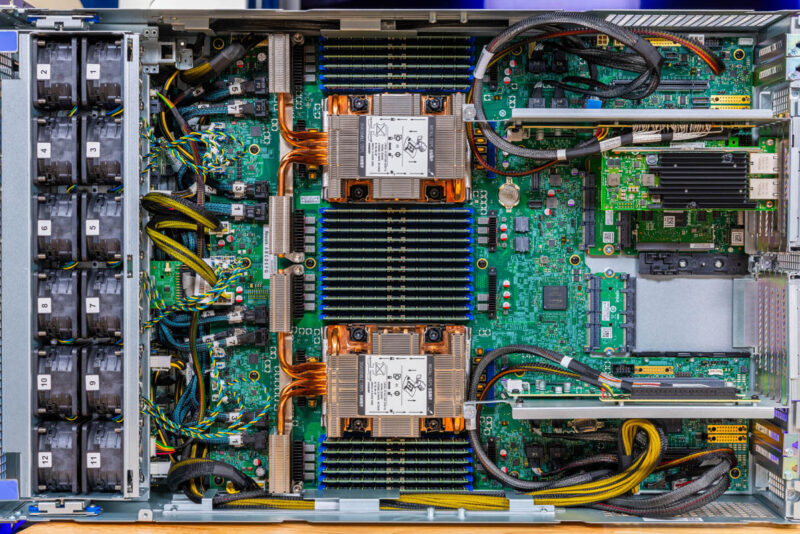
Generally these platforms just blast fans 24×7 to keep parts cool, but that can add a huge amount of power. Also, this test platform had more of the temperament of my 4 month old son. Sometimes it worked flawlessly, and sometimes you uninstall four DIMMs and it freaked out.
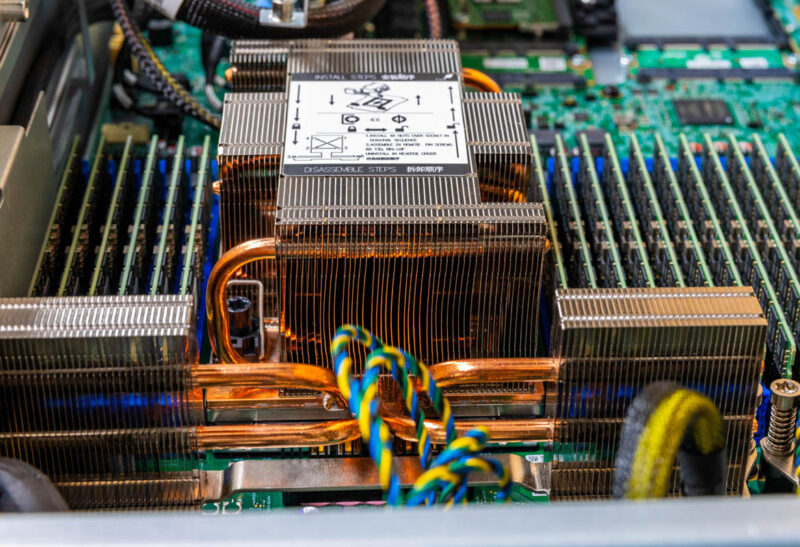
What we will simply say is this, each CPU can use 500W. Add to that another 120W or more for 24 DDR5 DIMMs, and a few watts for storage and other board components, and you are at around 1.2kW without cooling. One notable omission in the new systems however is the PCH, so that is 10W+ and a discrete part no longer sitting on the motherboard. Still, adding 10-20% for fans depending on the form factor and 1.3-1.6kW is going to be the new range for a dual socket server, before add-in cards or storage are brought into the mix. If you add a 100W+ NVIDIA BlueField-3 DPU, those numbers go up.
Something that Intel did, which was great, is that it showed a look at the power consumption of the CPUs below 100%. Most server CPUs do not run at 100% load. In fact, for a huge number of workloads, you do not want to run a CPU at 100% because that is when you start to see higher tail latencies, packets processed slowly, and so forth. Most cloud instances run at very low CPU utilization (under 25%.) As a result, the actual load on most CPUs in virtualization clusters is well under 50% at any given time. With that context, Intel showed that in the 30-70% utilization range it can get up to a 1.9x performance per watt gain.
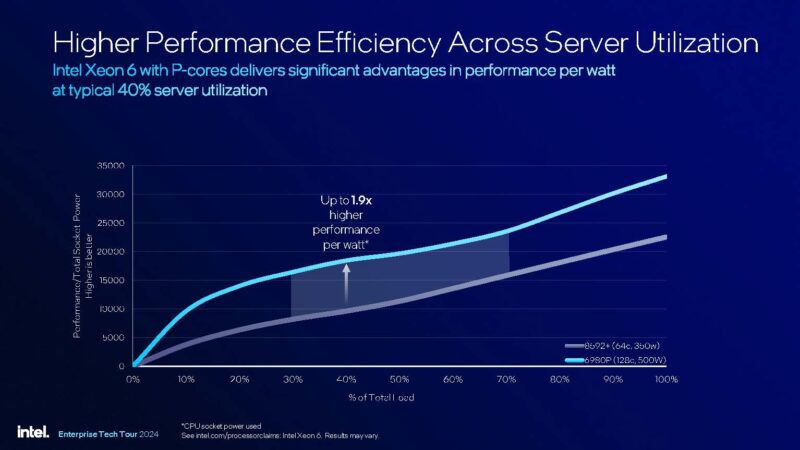
The chips may use more power per socket, but doubling the cores per socket while not doubling the TDP means we can get a lot more efficiency.
Key Lessons Learned: Market Impact
Normally we would go into a look at the impact to AMD’s parts, but let us take a step back for a moment. This is really the high-performance line from Intel. If you want better power efficiency for running web servers, Sierra Forest is the answer. If you want a storage server, you are probably buying an older generation CPU or waiting for the smaller socket P-core CPUs and the R1S configuration in Q1.
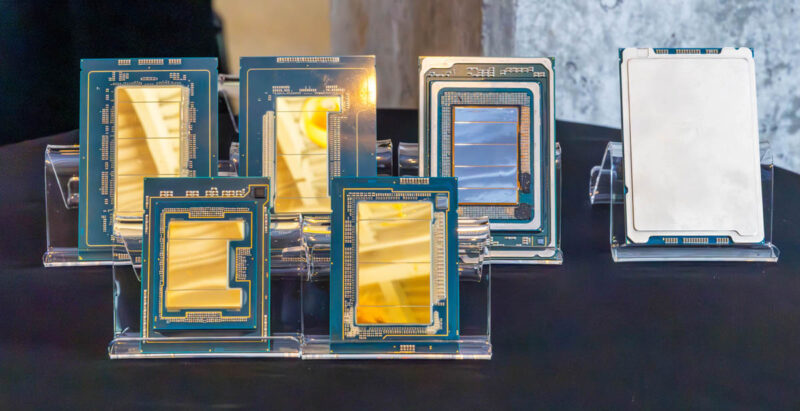
Since you can see it in the above photo, yes, there is an image of the upcoming 18A Clearwater Forest CPU where we expect the E-core CPUs to get very attractive.
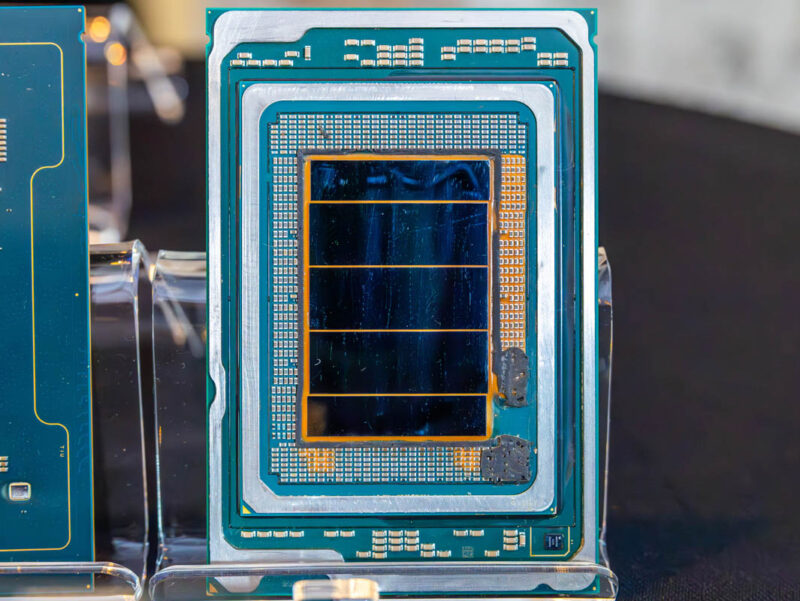
Still, from a raw performance perspective the Intel Xeon 6900P with 128 cores is stellar and takes the performance crown for now. Of course, AMD said Turin is coming in 2H 2024, so we are not far from AMD’s modern offering. In any event, Intel will be competing with the same core count, and a more comparable process technology, instead of at a 50% or more core count deficit and much older process technology that it has found itself at for half a decade.
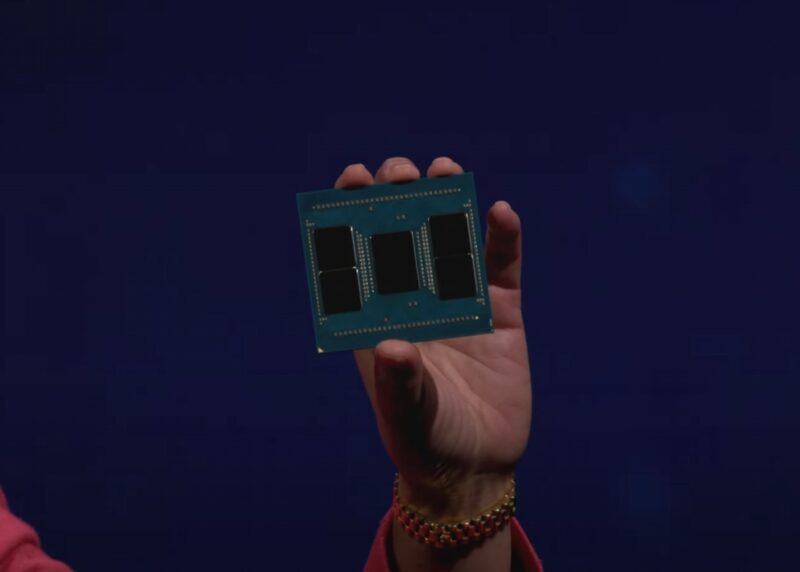
What is interesting is that competing with fewer cores meant that Intel has focused on things like AMX for AI inference acceleration, QuickAssist for crypto and compression that is now supported by default in Ubuntu.
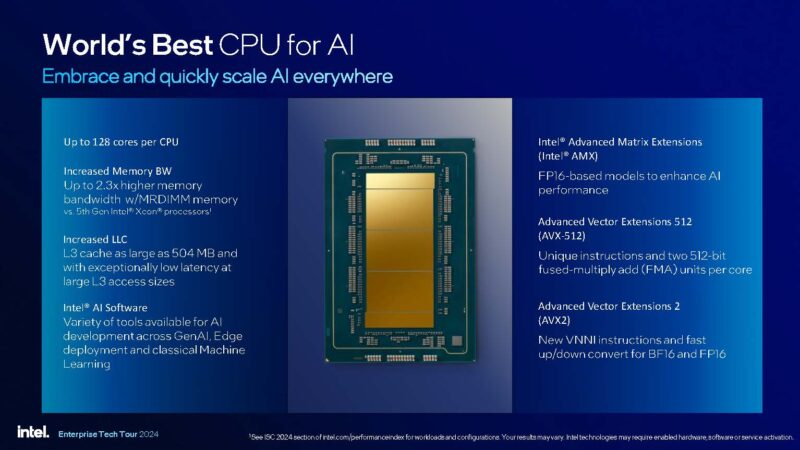
For those looking at more inference, Intel is also launching its Gaudi 3 AI accelerators today.
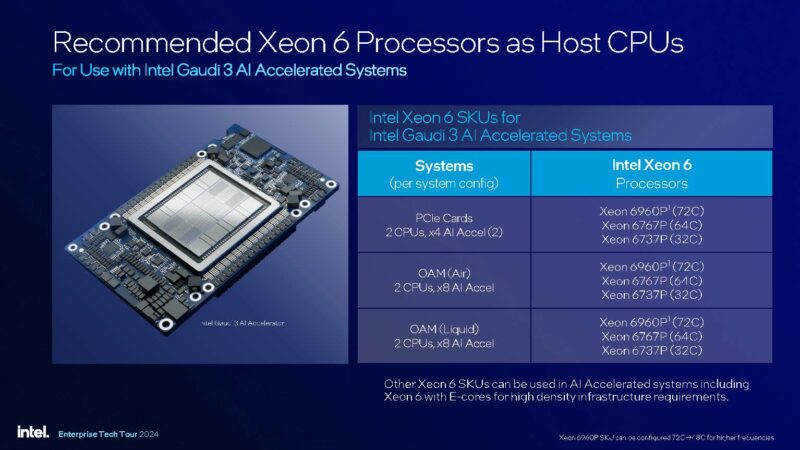
The big change is that Intel is also saying it is good for NVIDIA head nodes.
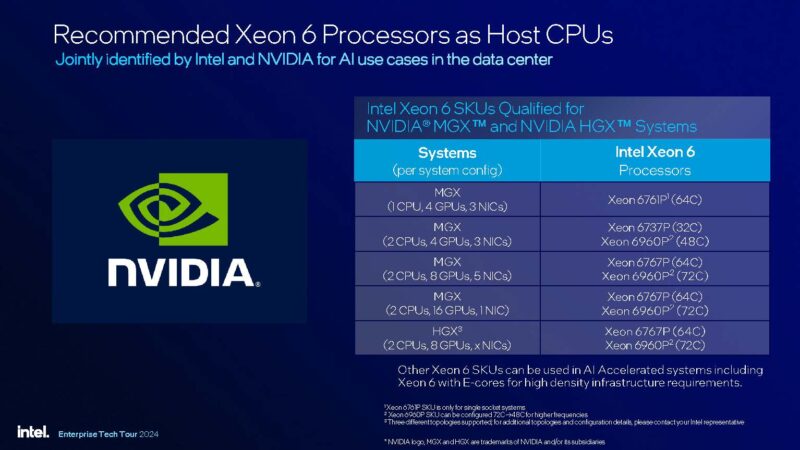
In the AI industry, one of the reasons companies like Supermicro took off was offering AMD EPYC versions of NVIDIA compute servers when AMD EPYC Genoa offered many more cores than Intel. Still, when you look at very large HGX H100 deployments, the 5th Gen Intel Xeon Emerald Rapids was extremely popular even at a core count deficit. One of the big reasons was just Intel’s memory controller and I/O die configuration. That advantage should be maintained with Granite Rapids, and the AMD EPYC advantage for higher core counts will go away. Still, in most AI servers four expensive GPUs are sold for each CPU.
Final Words
Intel Xeon 6 introduces a lot more complexity. P-cores, E-cores, 8 channel or 12 channel memory configurations, different memory types, accelerators and so forth. Through all of that though, there is one simple message: Intel is back. New process and packaging technology is allowing Intel to get back to core-to-core competitiveness with AMD. AMD will fire its Turin salvo soon-ish, and we will be back to debating architectures and accelerators. No longer will the question be 64 EPYC cores versus 28 Xeon cores, or 96 EPYC cores versus 64 Xeon cores. Intel is back in the game.
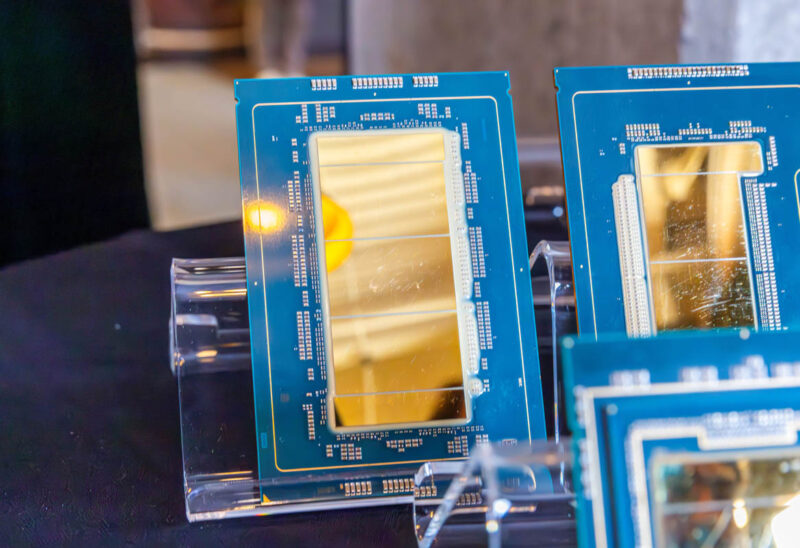
Of course, Intel is pursuing a much more complex strategy splitting E-cores and P-cores. My feedback to Intel last week that Sierra Forest-AP needs to be pulled into Q4 2024 so that Intel can have its cloud native 288 E-core versus 192 core/ 384 thread debate this year. Those CPUs, however are for a different segment.
For now, Intel has finally solved its core count issue, while also offering things like AMX, QAT, and more for acceleration, high-end DDR5 and MRDIMM (MCR DIMM) solutions for big memory bandwidth, and more. Intel lost its top-end edge when it lost process leadership with 10nm and Ice Lake. As the manufacturing and packaging side has improved, Intel is back in the fight. Welcome back Intel.


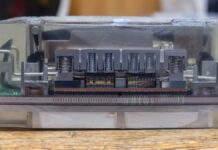
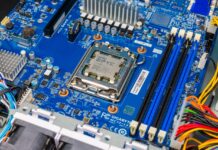
Wow can’t even hide Patrick’s love affair with Intel anymore can we ? Intel has not even properly launched this but yet it’s 128c Intel vs 96c Genoa, but AMD will have same 128c in 2 weeks time……just be honest finally and call it servingintel.com ;-)
Yawn… Still low on PCIe lanes for a server footprint when GPUs and NVME storage is coming fast and furious. Intel needs to be sold so someone can finally innovate.
Whether love or not, the numbers are looking good. For many an important question will be yield rates and pricing.
I wonder why Epyc is missing from the povray speed comparison.
One thing I’d like to see is a 4-core VM running Geekbench 6 while everything else is idle. After that Geekbench for an 8-core VM, 16-core, 32-core and so forth under similar circumstances. This sort of scaling analysis would help determine how well balanced the MCRDIMM memory subsystem is to the high-core-count processors–just the kind of investigative journalism needed right now.
As an asside, I had to work over eight captchas for this post.
The keyword would be availability. I checked just now, and these newer parts don’t have 1k Tray Pricing published yet. So not sure when would they be available. It felt painful to restrict the On-Premise Server procurement specification at 64 cores to get competitive bidding across vendors. Hope for the best.
It is hard not to get excited about competition, Intel has finally done it, they launched something faster than AMDs previous generation… Intel’s focus on AMX accelerations seems to have paid off, I guess we shall see when Turin launches in a few weeks.
@Patrick how do you manage to call ~53GB/S “closing in on” ~330GB/S? Even dual GR is slower by a factor of three.
Well there’s 90 minutes of my life well spent. I’d like to thank Patrick and the STH krew on this one.
Rodigas I didn’t get that sense at all. Intel’s the first to launch a 500W TDP part on a modern process and they’ve got cores and memory bandwidth so they’re winning for now. In Q4 when Turin is out we’ll say he loves AMD. It’s shaping up like Intel will at least show it’s competitive with Turin. That’s great for everyone.
Eric O – I’d like to see GB5 not 6. You’ve hit it before, GB6 is useless even for workstation class multicore.
Ram is right, these aren’t really available yet. Paper launch, or HyperScale only launch.
Emerth do you mean that 543391MB/S is much more than 330GB/S? The screenshots in the memory section show Intel’s far ahead. With MCRDIMMs adding 38% more bandwidth they’re getting close to 750GB/s on one CPU. So maybe they meant to say the Grace dual chip is almost up to a GR MCRDIMM single chip?
Intel’s doing a fine job. I can’t wait for 18A chips.
@RamShanker & francis:
– ASUS has a webpage up; search for ASUS “RS920Q-E12”, not quite for sale yet, but there’s a PDF.
– NextPlatform has published a guesstimate of 6980P U$24,980 and 6979P U$24,590; with lower prices for trays. Prices are fairly meaningless ATM with the competitor’s launch imminent.
> Intel is differentiating on things like features depending on the core type and SKU
Glad for the competition, but really wish they’d simplify the stack of SKUs. Is Intel On Demand gone?
Did Intel say why all the black ink on that Clearwater Forest chip?
That seems to be a very risky chip … gaa/bspd/hybrid bonding,18A all being introduced in the same chip. Did they actually demo one?
Never thought I’d see a vulture capitalist group (Apollo Global Management) investing in Intel. I thought Gelsinger was supposed to be Intel’s savior?
As others have pointed out, these seems a bit bias on the Intel side of things.
Yes, we’re all glad to see them finally getting their house in order and competing, but do better on containing your fanfare.
Wow. So many haters claiming bias. Go back and re-read the linked epic Rome review from 2019.
When I compare that to this one and all I see is that good products get good reviews (this one) and great products get great reviews (Rome). I also noticed how thankful Patrick is to have intel be competitive in the top of the line, which it is with this latest launch and how awesome it was back in 2019 to have AMD jump out and surpass intel just a few years after they were nearly bankrupt.
For detailed benchmarks I refer all to Phoronix – but a very nice piece by ServeTheHome.
many thanks, L
So, different kinds of “leadership” …
According to Micheal at Phoronix this year’s Intel 6980P is 12% faster than last year’s AMD 9684X.
But, the 6980P has 700 TDP and the 9684X has 400 TDP (while remembering that comparisons of their TDPs isn’t exactly equal) and AMD costs U$10K less. So, 75% more TDP and 5x more $ (unfairly comparing guestimated MSRP vs discount pricing). With the new Turin (coming RSN) offering moar Coors and a big bump over AMDs last generation; in the same socket.
Making a tortoise and hare comparison would be confusing as to who is who and who is ahead at a particular point in time.
We appreciate the effort it takes to put together these articles and enjoy reading them; except for the shameful core latency mushy pea soup image, while other sites has tack sharp puny numbers and a reasonable sized image file nonetheless.
I need Intel to go up so I can give Grandma her retirement back…
We all know Turin is coming. At least AMD now needs to push really hard instead of just coasting because Intel’s been so far behind. Let Intel have its weeks at the top.
On the plus Epyc now has some competition coming. The one big pain point will be software licensing where it’s licensed per Core.
What is up with that lscpu output for the SNC3 configuration? It reports:
Node 0: 43 threads
Node 1: 43 threads
Node 2: 73 threads
Node 3: 86 threads
Node 4: 86 threads
Node 5: 84 threads
And then threads 256-352 are completely unaccounted.
@emerth: I see 0.5TB/s in stream on 128 cores while NVLD seems to go to 0.6 TB/s — so I’d agree with “closing” here.
Intel fanboys forgot AMD Turin with 192 cores? That is always the case, Intel concentrated for quarter year profits instead of keeping R&D on good shape. Now better to concentrate selling factories to someones that need “old school” stuff. Game over. There could be some ligth if they could boost soon out 256 c, which is very unlikely. AMD will do it soon anyway, most likely minor change to just add 20 % more cores. But fanboys are fanboys and always forgotting the truth.